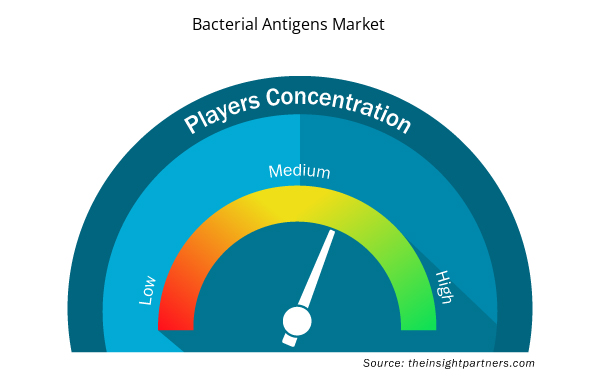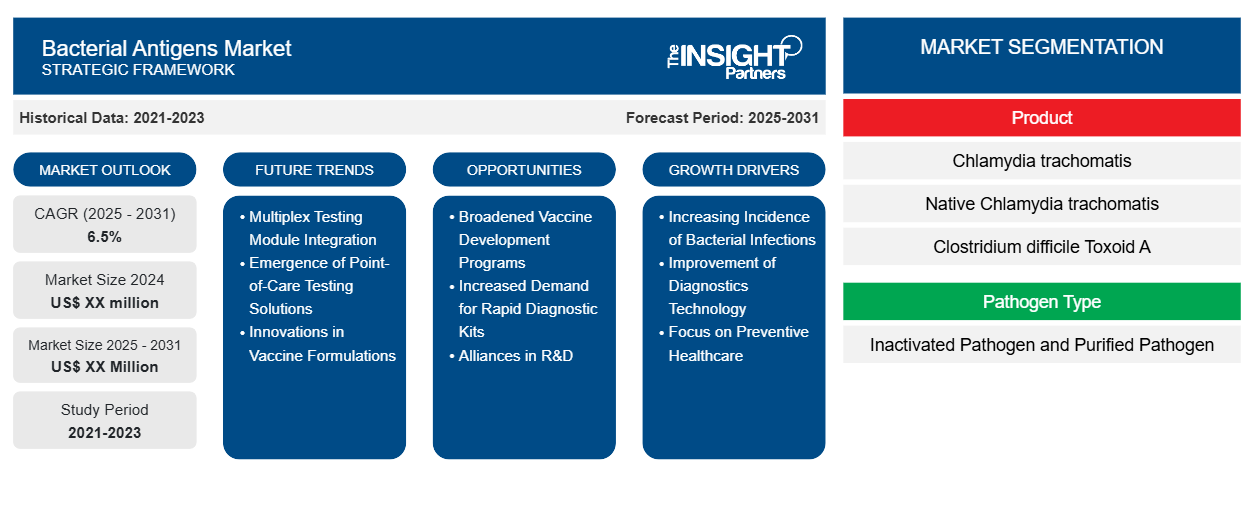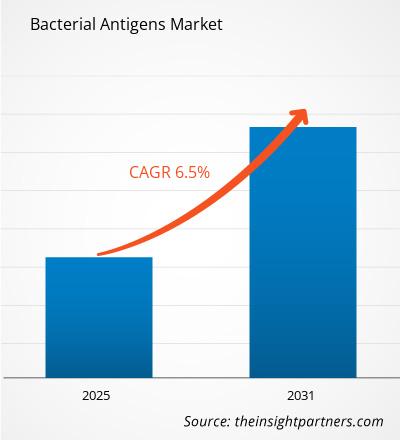Der Markt für bakterielle Antigene wird voraussichtlich von 2023 bis 2031 eine durchschnittliche jährliche Wachstumsrate (CAGR) von 6,5 % verzeichnen, wobei die Marktgröße von XX Millionen US-Dollar im Jahr 2023 auf XX Millionen US-Dollar im Jahr 2031 wachsen wird.
Der Bericht ist segmentiert nach Produkt (Chlamydia trachomatis, natives Chlamydia trachomatis, Clostridium difficile Toxoid A, Clostridium difficile Toxoid B, native Lipoteichonsäure, Neisseria gonorrhoeae, rekombinantes Protein G und Trichomonas vaginalis), Erregertyp (inaktivierter Erreger und gereinigter Erreger), Anwendung (ELISA, Immunoassay, SDS-PAGE, Hämagglutination und Agglutinationstest), Endbenutzer (Krankenhäuser und Kliniken, Diagnoselabore und -zentren, akademische und Forschungsinstitute).
Zweck des Berichts
Der Bericht „Markt für bakterielle Antigene“ von The Insight Partners soll die aktuelle Situation und das zukünftige Wachstum sowie die wichtigsten treibenden Faktoren, Herausforderungen und Chancen beschreiben. Dies wird verschiedenen Geschäftspartnern Einblicke geben, wie zum Beispiel:
- Technologieanbieter/-hersteller: Um die sich entwickelnde Marktdynamik zu verstehen und die potenziellen Wachstumschancen zu kennen, damit sie fundierte strategische Entscheidungen treffen können.
- Investoren: Durchführung einer umfassenden Trendanalyse hinsichtlich der Marktwachstumsrate, der finanziellen Marktprognosen und der Chancen entlang der Wertschöpfungskette.
- Regulierungsbehörden: Zur Regulierung von Richtlinien und Überwachungsaktivitäten auf dem Markt mit dem Ziel, Missbrauch zu minimieren, das Vertrauen der Anleger zu bewahren und die Integrität und Stabilität des Marktes aufrechtzuerhalten.
Bakterielle Antigene Marktsegmentierung
Produkt
- Chlamydia trachomatis
- Einheimische Chlamydia trachomatis
- Clostridium difficile Toxoid A
- Clostridium difficile Toxoid B
- Native Lipoteichonsäure
- Neisseria gonorrhoeae
- Rekombinantes Protein G
- Trichomonas vaginalis
Erregertyp
- Inaktivierter Pathogen und gereinigter Pathogen
Anwendung
- ELISA
- Immunassay
- SDS-SEITE
- Hämagglutination
- Agglutinationstest
Endbenutzer
- Krankenhäuser & Kliniken
- Diagnostische Labore und Zentren
- Akademische und Forschungsinstitute
Endbenutzer
- Krankenhäuser & Kliniken
- Diagnostische Labore und Zentren
- Akademische und Forschungsinstitute
Passen Sie diesen Bericht Ihren Anforderungen an
Sie erhalten kostenlose Anpassungen an jedem Bericht, einschließlich Teilen dieses Berichts oder einer Analyse auf Länderebene, eines Excel-Datenpakets sowie tolle Angebote und Rabatte für Start-ups und Universitäten.
- Holen Sie sich die wichtigsten Markttrends aus diesem Bericht.Dieses KOSTENLOSE Beispiel umfasst eine Datenanalyse von Markttrends bis hin zu Schätzungen und Prognosen.
Wachstumstreiber auf dem Markt für bakterielle Antigene
- Zunehmende Häufigkeit bakterieller Infektionen: Die zunehmende Häufigkeit bakterieller Infektionen ist die treibende Kraft auf dem Markt für bakterielle Antigene. Neue Bakterienstämme und wachsende Antibiotikaresistenzen haben einen dringenden Bedarf an wirksamen Diagnose- und Präventionsinstrumenten geschaffen. Antigene spielen eine wichtige Rolle bei der schnellen und genauen Identifizierung der betreffenden Krankheitserreger und befeuern die Nachfrage nach innovativen Diagnosetests und Impfstoffen, die diese Antigene für ein verbessertes öffentliches Gesundheitsmanagement nutzen.
- Verbesserung der Diagnosetechnologie: Diese Fortschritte in der Diagnosetechnologie treiben das Wachstum des Marktes für bakterielle Antigene voran. Zu diesen neuen Technologien gehören PCR und Immunassays, die eine schnellere und präzisere Identifizierung bakterieller Krankheitserreger ermöglichen. Dies führt wiederum zu einer erhöhten Nachfrage nach bakteriellen Antigenen, die in solchen Tests verwendet werden, sodass Gesundheitsdienstleister Infektionen frühzeitig erkennen und so die Ausbreitung von Krankheiten verhindern und Behandlungspläne mit guten Ergebnissen für die Patienten individualisieren können.
- Fokus auf präventive Gesundheitsfürsorge: Die zunehmende Bedeutung präventiver Gesundheitsfürsorge treibt den Markt für bakterielle Antigene an. Diese Entwicklung umfasst innovative Forschung und Impfstoffe gegen die Krankheit durch bakterielle Antigene als vorbeugende Schutzmaßnahme gegen die meisten Krankheitsinfektionen. Ergänzt werden diese Entwicklungen durch staatliche Gesundheitsbehörden, die große Impfkampagnen durchführen, deren Ziel darin besteht, die Fallzahlen verschiedener übertragbarer Krankheiten zu senken.
Markttrends für bakterielle Antigene
- Integration von Multiplex-Testmodulen:
Die Integration von Multiplex-Testsystemen, die mehrere bakterielle Krankheitserreger gleichzeitig erkennen können, hat sich als wichtiger Trend auf dem Markt für bakterielle Antigene herauskristallisiert. Dies erhöht die Effizienz und Genauigkeit und verkürzt die Zeit bis zur Diagnose und Behandlung. Eine solche Ergänzung ist im klinischen Umfeld aufgrund der zunehmenden Komplexität und Koinfektionen erforderlich, was die Nachfrage nach einer Vielzahl bakterieller Antigene, die umfassende Tests ermöglichen, weiter steigert. - Aufkommen von Point-of-Care-Testlösungen:
POC-Tests revolutionieren den Markt für bakterielle Antigene, indem sie Diagnosen schneller und allgemeiner verfügbar machen. Diese tragbaren, einfachen und leicht zu bedienenden Geräte ermöglichen es dem Gesundheitspersonal, Tests in schwer erreichbaren, unterversorgten Gebieten schnell durchzuführen, wodurch Verzögerungen bei Diagnose und Behandlung minimiert werden. Daher besteht eine zunehmende Nachfrage nach bakteriellen Antigenen, die solche POC-Tests bestehen könnten, um frühe Ergebnisse zu erzielen und so bessere Patientenergebnisse und eine reibungslosere Gesundheitsversorgung zu unterstützen. - Innovationen bei Impfstoffformulierungen:
Ein wichtiger Trend auf dem Markt für bakterielle Antigene ist die Entwicklung formulierter Impfstoffe für bestimmte Indikationen. Mittlerweile wurden hochentwickelte, künstlich hergestellte Impfstoffe entwickelt, die durch bakterielle Antigenstimulation eine starke und dauerhafte Immunität hervorrufen. Solche Trends ergänzen die Impfstoffanwendungsprogramme in verschiedenen Teilen der Welt und gehen gleichzeitig das Problem der Antibiotikaresistenz an, indem sie den Bedarf an Antibiotika verringern. Die verbesserte Entwicklung von Impfstoffen treibt auch die Marktnachfrage nach bakteriellen Antigenen an.
Marktchancen für bakterielle Antigene
- Erweiterte Impfstoffentwicklungsprogramme:
Durch die Ausweitung der Impfstoffentwicklungsprogramme ergeben sich für die Märkte für bakterielle Antigene deutlich größere Wachstumschancen. Viele Regierungen und Pharmaunternehmen investieren viel in die Entwicklung und Herstellung neuartiger Impfstoffe gegen antibiotikaresistente Bakterien und andere neue Krankheitserreger. Der verstärkte Fokus auf Impfstoffinnovationen schafft einen starken Bedarf an bakteriellen Antigenen als wesentlichen Bestandteilen und schafft so einen starken Markt für die Entwicklung antigenbasierter Impfstoffe.markeplace for antigen-based vaccine development. - Erhöhte Nachfrage nach Schnelldiagnosekits:
Die steigende Nachfrage nach Schnelldiagnosekits im medizinischen Bereich ist eine der großen Aussichten für den Markt für bakterielle Antigene. Tatsächlich streben Gesundheitssysteme auf der ganzen Welt ständig nach schnelleren Diagnosen, um die weitere Übertragung von Infektionskrankheiten in der Bevölkerung zu verhindern. Folglich besteht eine größere Nachfrage nach bakteriellen Antigenen, die in Point-of-Care- und Schnelldiagnosetests eingesetzt werden. Daher ist dieses Szenario für den wachsenden Markt von Vorteil, insbesondere in den Regionen, die wirksame Diagnoselösungen für bakterielle Infektionen wünschen. - Allianzen in Forschung und Entwicklung:
Gemeinsame Partnerschaften von Wissenschaft und Industrie mit Regierungsbehörden sind Chancen für den Markt für bakterielle Antigene. Bis zur Einführung gemeinsamer Forschungsstudien zu bakteriellen Antigenen, die zu Diagnose- und Therapieprodukten führen, sind neue Entdeckungen vorprogrammiert. Dieser Rahmen kann genutzt werden, um die Entwicklung fortschrittlicher antigenbasierter Produkte zur effektiven Behandlung und Vorbeugung bakterieller Infektionen zu beschleunigen und so das Marktpotenzial weiter zu steigern.
Regionale Einblicke in den Markt für bakterielle Antigene
Die regionalen Trends und Faktoren, die den Markt für bakterielle Antigene während des Prognosezeitraums beeinflussen, wurden von den Analysten von Insight Partners ausführlich erläutert. In diesem Abschnitt werden auch die Marktsegmente und die Geografie für bakterielle Antigene in Nordamerika, Europa, im asiatisch-pazifischen Raum, im Nahen Osten und Afrika sowie in Süd- und Mittelamerika erörtert.

- Erhalten Sie regionale Daten zum Markt für bakterielle Antigene
Umfang des Marktberichts zu bakteriellen Antigenen
| Berichtsattribut | Details |
|---|---|
| Marktgröße im Jahr 2023 | XX Millionen US-Dollar |
| Marktgröße bis 2031 | XX Millionen US-Dollar |
| Globale CAGR (2023 - 2031) | 6,5 % |
| Historische Daten | 2021-2022 |
| Prognosezeitraum | 2024–2031 |
| Abgedeckte Segmente | Nach Produkt
|
| Abgedeckte Regionen und Länder | Nordamerika
|
| Marktführer und wichtige Unternehmensprofile |
|
Marktteilnehmerdichte für bakterielle Antigene: Auswirkungen auf die Geschäftsdynamik verstehen
Der Markt für bakterielle Antigene wächst rasant, angetrieben durch die steigende Nachfrage der Endnutzer aufgrund von Faktoren wie sich entwickelnden Verbraucherpräferenzen, technologischen Fortschritten und einem größeren Bewusstsein für die Vorteile des Produkts. Mit steigender Nachfrage erweitern Unternehmen ihr Angebot, entwickeln Innovationen, um die Bedürfnisse der Verbraucher zu erfüllen, und nutzen neue Trends, was das Marktwachstum weiter ankurbelt.
Die Marktteilnehmerdichte bezieht sich auf die Verteilung von Firmen oder Unternehmen, die in einem bestimmten Markt oder einer bestimmten Branche tätig sind. Sie gibt an, wie viele Wettbewerber (Marktteilnehmer) in einem bestimmten Marktraum im Verhältnis zu seiner Größe oder seinem gesamten Marktwert präsent sind.
Die wichtigsten auf dem Markt für bakterielle Antigene tätigen Unternehmen sind:
- Bio-Rad Laboratories, Inc.
- Enzo Life Sciences, Inc.
- Kreative Diagnostik
- Die Native Antigen Company Ltd.
- QED Bioscience Inc.
Haftungsausschluss : Die oben aufgeführten Unternehmen sind nicht in einer bestimmten Reihenfolge aufgeführt.

- Erhalten Sie einen Überblick über die wichtigsten Akteure auf dem Markt für bakterielle Antigene
Wichtige Verkaufsargumente
- Umfassende Abdeckung: Der Bericht deckt die Analyse von Produkten, Dienstleistungen, Typen und Endbenutzern des Marktes für bakterielle Antigene umfassend ab und bietet einen ganzheitlichen Überblick.
- Expertenanalyse: Der Bericht basiert auf dem umfassenden Verständnis von Branchenexperten und Analysten.
- Aktuelle Informationen: Der Bericht stellt durch die Abdeckung aktueller Informationen und Datentrends Geschäftsrelevanz sicher.
- Anpassungsoptionen: Dieser Bericht kann angepasst werden, um spezifische Kundenanforderungen zu erfüllen und die Geschäftsstrategien optimal anzupassen.
Der Forschungsbericht zum Markt für bakterielle Antigene kann daher dabei helfen, die Branchensituation und Wachstumsaussichten zu entschlüsseln und zu verstehen. Obwohl es einige berechtigte Bedenken geben kann, überwiegen die allgemeinen Vorteile dieses Berichts tendenziell die Nachteile.
- Historische Analyse (2 Jahre), Basisjahr, Prognose (7 Jahre) mit CAGR
- PEST- und SWOT-Analyse
- Marktgröße Wert/Volumen – Global, Regional, Land
- Branche und Wettbewerbsumfeld
- Excel-Datensatz



Report Coverage
Revenue forecast, Company Analysis, Industry landscape, Growth factors, and Trends

Segment Covered
This text is related
to segments covered.

Regional Scope
North America, Europe, Asia Pacific, Middle East & Africa, South & Central America

Country Scope
This text is related
to country scope.
Häufig gestellte Fragen
The bacterial antigens market is estimated to grow with a CAGR of 6.5% from 2023 to 2031.
Asia Pacific region is likely to witness fastest growth rate during the forecast period.
The market drivers include increasing incidence of bacterial infections and improvement of diagnostics technology are driving the bacterial antigens market
The bacterial antigens market majorly consists of the players such as Bio-Rad Laboratories, Inc., Enzo Life Sciences, Inc., Creative Diagnostics among others.
Multiplex testing module integration are likely to remain the key trend during the forecast period
North America dominated the bacterial antigens market in 2023
Trends and growth analysis reports related to Life Sciences : READ MORE..
1. Bio-Rad Laboratories, Inc.
2. Enzo Life Sciences, Inc.
3. Creative Diagnostics
4. The Native Antigen Company Ltd.
5. QED Bioscience Inc.
6. Microbix Biosystems
7. Ross Southern Laboratories
8. Jena Bioscience GmbH
9. SERION Immunologics
10. AROTEC Diagnostics
The Insight Partners performs research in 4 major stages: Data Collection & Secondary Research, Primary Research, Data Analysis and Data Triangulation & Final Review.
- Data Collection and Secondary Research:
As a market research and consulting firm operating from a decade, we have published and advised several client across the globe. First step for any study will start with an assessment of currently available data and insights from existing reports. Further, historical and current market information is collected from Investor Presentations, Annual Reports, SEC Filings, etc., and other information related to company’s performance and market positioning are gathered from Paid Databases (Factiva, Hoovers, and Reuters) and various other publications available in public domain.
Several associations trade associates, technical forums, institutes, societies and organization are accessed to gain technical as well as market related insights through their publications such as research papers, blogs and press releases related to the studies are referred to get cues about the market. Further, white papers, journals, magazines, and other news articles published in last 3 years are scrutinized and analyzed to understand the current market trends.
- Primary Research:
The primarily interview analysis comprise of data obtained from industry participants interview and answers to survey questions gathered by in-house primary team.
For primary research, interviews are conducted with industry experts/CEOs/Marketing Managers/VPs/Subject Matter Experts from both demand and supply side to get a 360-degree view of the market. The primary team conducts several interviews based on the complexity of the markets to understand the various market trends and dynamics which makes research more credible and precise.
A typical research interview fulfils the following functions:
- Provides first-hand information on the market size, market trends, growth trends, competitive landscape, and outlook
- Validates and strengthens in-house secondary research findings
- Develops the analysis team’s expertise and market understanding
Primary research involves email interactions and telephone interviews for each market, category, segment, and sub-segment across geographies. The participants who typically take part in such a process include, but are not limited to:
- Industry participants: VPs, business development managers, market intelligence managers and national sales managers
- Outside experts: Valuation experts, research analysts and key opinion leaders specializing in the electronics and semiconductor industry.
Below is the breakup of our primary respondents by company, designation, and region:

Once we receive the confirmation from primary research sources or primary respondents, we finalize the base year market estimation and forecast the data as per the macroeconomic and microeconomic factors assessed during data collection.
- Data Analysis:
Once data is validated through both secondary as well as primary respondents, we finalize the market estimations by hypothesis formulation and factor analysis at regional and country level.
- Macro-Economic Factor Analysis:
We analyse macroeconomic indicators such the gross domestic product (GDP), increase in the demand for goods and services across industries, technological advancement, regional economic growth, governmental policies, the influence of COVID-19, PEST analysis, and other aspects. This analysis aids in setting benchmarks for various nations/regions and approximating market splits. Additionally, the general trend of the aforementioned components aid in determining the market's development possibilities.
- Country Level Data:
Various factors that are especially aligned to the country are taken into account to determine the market size for a certain area and country, including the presence of vendors, such as headquarters and offices, the country's GDP, demand patterns, and industry growth. To comprehend the market dynamics for the nation, a number of growth variables, inhibitors, application areas, and current market trends are researched. The aforementioned elements aid in determining the country's overall market's growth potential.
- Company Profile:
The “Table of Contents” is formulated by listing and analyzing more than 25 - 30 companies operating in the market ecosystem across geographies. However, we profile only 10 companies as a standard practice in our syndicate reports. These 10 companies comprise leading, emerging, and regional players. Nonetheless, our analysis is not restricted to the 10 listed companies, we also analyze other companies present in the market to develop a holistic view and understand the prevailing trends. The “Company Profiles” section in the report covers key facts, business description, products & services, financial information, SWOT analysis, and key developments. The financial information presented is extracted from the annual reports and official documents of the publicly listed companies. Upon collecting the information for the sections of respective companies, we verify them via various primary sources and then compile the data in respective company profiles. The company level information helps us in deriving the base number as well as in forecasting the market size.
- Developing Base Number:
Aggregation of sales statistics (2020-2022) and macro-economic factor, and other secondary and primary research insights are utilized to arrive at base number and related market shares for 2022. The data gaps are identified in this step and relevant market data is analyzed, collected from paid primary interviews or databases. On finalizing the base year market size, forecasts are developed on the basis of macro-economic, industry and market growth factors and company level analysis.
- Data Triangulation and Final Review:
The market findings and base year market size calculations are validated from supply as well as demand side. Demand side validations are based on macro-economic factor analysis and benchmarks for respective regions and countries. In case of supply side validations, revenues of major companies are estimated (in case not available) based on industry benchmark, approximate number of employees, product portfolio, and primary interviews revenues are gathered. Further revenue from target product/service segment is assessed to avoid overshooting of market statistics. In case of heavy deviations between supply and demand side values, all thes steps are repeated to achieve synchronization.
We follow an iterative model, wherein we share our research findings with Subject Matter Experts (SME’s) and Key Opinion Leaders (KOLs) until consensus view of the market is not formulated – this model negates any drastic deviation in the opinions of experts. Only validated and universally acceptable research findings are quoted in our reports.
We have important check points that we use to validate our research findings – which we call – data triangulation, where we validate the information, we generate from secondary sources with primary interviews and then we re-validate with our internal data bases and Subject matter experts. This comprehensive model enables us to deliver high quality, reliable data in shortest possible time.


 Holen Sie sich ein kostenloses Muster für diesen Bericht
Holen Sie sich ein kostenloses Muster für diesen Bericht